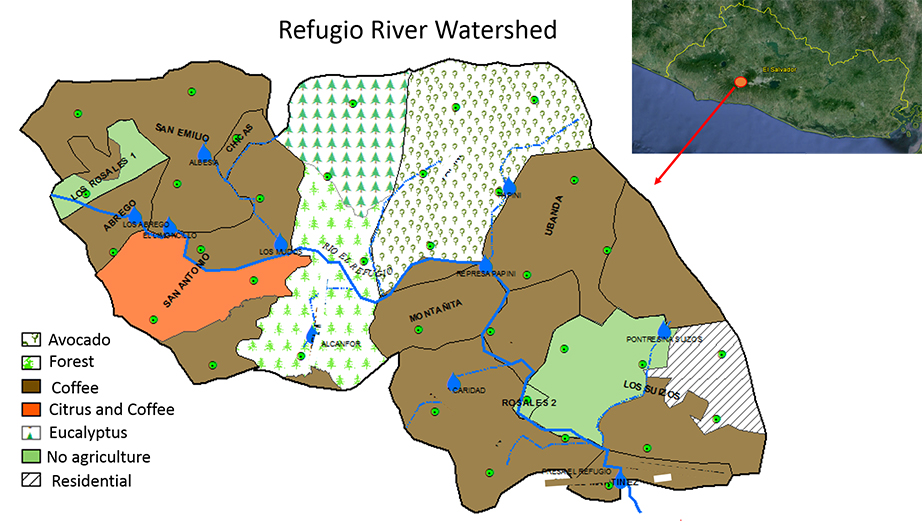Cheers to the coffee world out there. From the consumers to the farmers who grow it, to market participants and NGOs who work to support it… To all of us who live and breathe coffee.
I found myself in a meeting a couple weeks ago that took me back to Re:Co Symposium and SCAA Atlanta in April- my first (yes, I was a fellow- thanks S&D;) At SCAA I was quickly reminded how complex coffee is – (Kraig sent me this article from eater.com the other day, shares the anxiety that can quickly overcome you as you begin to think about the complexity of coffee) from all the flavors, brewing methods, to issues the farmers face and – of course – CLIMATE CHANGE.
I went to all the climate change talks possible, and one thing stood out—WATER! From drought to temperature changes to lack of groundwater for irrigation. A woman came up to me after one talk to show me photos of her farms in Honduras and how dry they are. The future of growing coffee is changing. As Mark Lundy from CIAT (highly recommend watching Making Progress on Climate Change- when Re:Co posts it, kept saying over and over, “This is the scenario if we do nothing.” This meeting I went to the other day was an example people doing SOMETHING.
The meeting took place in the Balsamo Mountain Range, just southwest of San Salvador. A mountain range that follows the Salvadoran coast east to west. The highest altitude is approximately 1,500 meters and the mountains are dotted with shade grown coffee farms throughout. Our local Blue Harvest team works here in the Comasagua Municipality. The potable water source for the urban town of Comasagua, with over 2,500 people, is a river called Rio Refugio. Rio Refugio flows from a bowl-shaped mountain side whose watershed is an area of about 112 hectares (277 acres). In order to understand the situation of the water source and agricultural landscape, Blue Harvest and AGRITEC developed a complete land use and soil map of the watershed.
Our local coordinator, Rafael Huezo, was presenting the results of the study to a group of mixed landowners – large, medium, cooperatives, and small. He was saying, “We need to work in the whole watershed, but we need to prioritize certain areas.” The maps were clear. 16 farms make up the watershed with the Refugio River running straight through the middle.
10 springs feed the river, and are spread throughout the upper parts of the watershed located within these farms. Soil mapping results were provided to each landowner, and a schedule was set to review the results to define appropriate fertility and soil nutrition plans. Then, the conversation turned to how they could make sure the water filters into the ground for plant production and keeps the water springs fed, ensuring potable water for Comasagua. Each farm participant explained what they were doing on their land to keep the water infiltrating and not lost to runoff. Some talked of terracing, infiltration works, staggered plants along contour lines, increasing ground cover and canopy cover.
But quickly the conversation turned towards markets. No matter how hard one tries to focus on soil and water conservation practices with coffee farmers, the conversation in the end always turns to markets. I mean, really, it is one of the key short-term sustainability first steps. You need to sell coffee in order to stay in coffee. The group began discussing how they can sell their coffee with a differential to go towards water conservation. How can they promote investments in this watershed for not only improving coffee quality (now they produce varieties from Marsellesa, Bourbon, and Caturras), but in the infrastructure and efforts to keep Comasagua drinking? How can a group of mixed sized farms come together to protect their watershed to benefit both their farms’ production and the people downstream? How can buyers from far away get involved and support this practice? How much of a differential would buyers be willing to pay?
These are all questions we are looking to answer. This group from Rio Refugio is lucky. They have the blueprint of their watershed and the farms’ position in it. This skeleton of their land and watershed shows them exactly where to prioritize in order to have the best hydrological impact. They know which areas are key infiltration points due to soil types. They have necessary information about the soils on their farms to be able to improve fertility and production of their farms specifically based on what their plants and soils need. Now, they need to get the right price to keep it going.
– Maren Barbee, Regional Manager of Blue Harvest Central America, CRS




